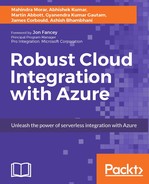Unity makes strength. | ||
| --Motto | ||
This book is about building modern integration solutions in the cloud using Microsoft Azure technologies, enabling connectivity to Software as a Service (SaaS) applications such as Salesforce and Dropbox. Azure is Microsoft's premier cloud platform. It also looks at how to extend the reach of existing on-premises integration solutions and other legacy Line of Business (LOB) systems by connecting them to the cloud.
We also discuss important design patterns to build distributed systems in the cloud, such as the microservices pattern that builds on the principles of service-oriented architecture (SOA). We highlight some of the issues encountered when integrating traditional on-premises systems and how they can be solved, applying some of these learnings to the next generation of cloud-based applications.
We will discuss and demonstrate some of the Azure technologies using a full turnkey demonstration scenario as follows:
- Azure App Service: This is a new, fully managed Platform as a Service (PaaS) cloud solution in order to host web, mobile, and integration applications. In this book, we will be focusing primarily on API Apps, Logic Apps, and Web Apps (along with associated connectors):
- API Apps: Build robust, scalable, and secure API backends for your web, mobile, and enterprise applications
- Azure Service Bus: Which comprises queues, topics, and relays
- Logic Apps: Automate business processes in a workflow and run them reliably in the cloud
- API Management: How to monitor APIs running in Azure and secure them using Azure Active Directory and OAuth
- Azure Storage: Blobs
- Application Insights: Get a view on how the various components comprising that your integration solution are working
- Event Hubs/IoT Hubs: Connect devices in the field and obtain valuable insights that can drive business automation and revenue
- Azure Functions: Trigger the execution of code on demand
- ASP.NET Webhooks: Notify subscribers that an event has occurred via an asynchronous callback
- BizTalk Server 2016 Cloud Adapters: Extend the reach of on-premises BizTalk into the cloud using the new Logic App adapter, for example
The cloud offering for on-premises systems will be examined, showing, for example, how to hook up BizTalk Server running in a local company data center to Azure using the new features of BizTalk Server 2016. Here, we will see how BizTalk on-premises can extend business capabilities into new territories not thought of before, well beyond the company firewall in a secure manner, reaching into third-party SaaS providers.
Businesses are realizing that with the right solutions in place, they can use the cloud to create extra competitive advantage, new business opportunities, and hence revenue by extending the capabilities of their IT, creating next generation solutions and also by enhancing existing applications. This is achievable through streamlined and responsive business automation in the cloud, which provides reliable and rich data to frontline applications. In this book, we seek to show how this can be done.
Azure is Microsoft's cloud computing platform that comprises a collection of software services that can be hosted outside the traditional company IT infrastructure and provides an avenue to getting started quickly building and hosting software, in a flexible pricing business model.
A good place to learn more about Azure is via the Azure website: https://azure.microsoft.com .
The following is a list of current service categories available in Azure:
- Compute: This is a high-level description of base services that provide a platform in order to run other applications and tasks, for example, virtual machines running Windows and Linux and platforms such as Service Fabric that act as a hosting platform within which applications can run.
- Web and Mobile: This includes services in order to run web and mobile applications, from the backend services required to the frontend web applications.
- Data and Storage: This includes relational and non-relational database systems including raw binary storage of data.
- Services focused on cognitive services and artificial intelligence.
- Analytics: This includes services in order to process large quantities of data using techniques such as machine learning as well as large-scale data transformation and movement.
- Internet of Things: This manages IoT assets on a big scale using IoT Hubs and processes real-time events and data using services such as Stream Analytics.
- Networking: This includes features such as load balancing, DNS, high-speed dedicated connections to Azure (ExpressRoute), and the configuration of private networks within Azure.
- Media and CDN: Robust content delivery through a distributed network of proxy servers deployed in multiple data centers across multiple regions.
- Enterprise Integration: This includes technologies in order to link on-premises and cloud-based systems, which encompasses Logic Apps, Service Bus, API Management, Functions, and BizTalk.
- Identity and Access Management: This includes authentication and authorization services using Active Directory in the cloud (with sync available to on-premises directories) and multifactor authentication.
- Developer Services: This includes services for the application developer including functionality such as Visual Studio Team Services for software development support and Application Insights that offers real-time monitoring of applications.
- Management: This assists with management tasks such as key management and offers task automation.
